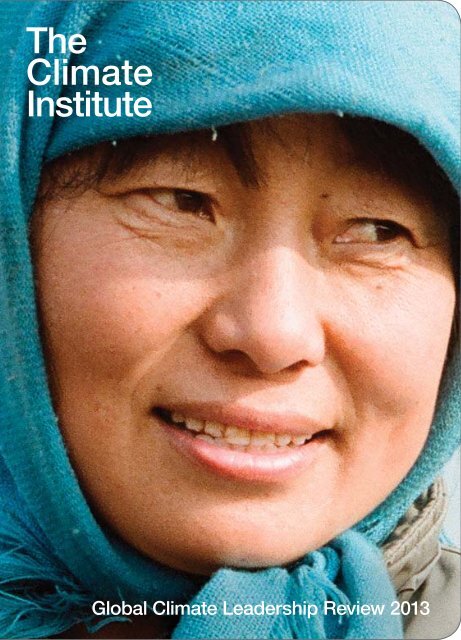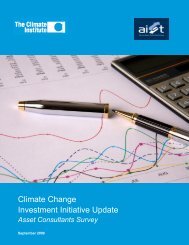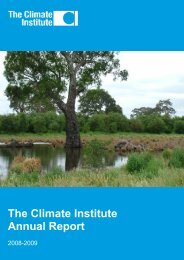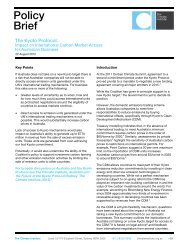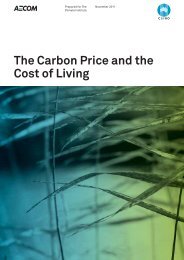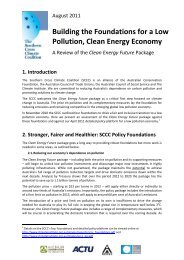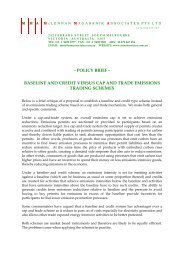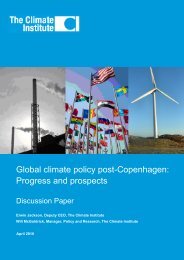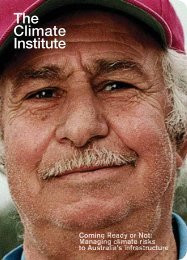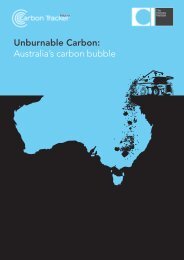Global Climate Leadership Review 2013 - The Climate Institute
Global Climate Leadership Review 2013 - The Climate Institute
Global Climate Leadership Review 2013 - The Climate Institute
Create successful ePaper yourself
Turn your PDF publications into a flip-book with our unique Google optimized e-Paper software.
<strong>The</strong><strong>Climate</strong><strong>Institute</strong><strong>Global</strong> <strong>Climate</strong> <strong>Leadership</strong> <strong>Review</strong> <strong>2013</strong>
<strong>Global</strong> <strong>Climate</strong><strong>Leadership</strong> <strong>Review</strong> <strong>2013</strong>This report provides<strong>The</strong> <strong>Climate</strong> <strong>Institute</strong>’s overview ofAustralian climate policy in a globalcontext. It aims to elaborate onthe implications of global climatediplomacy and domestic actionsfor Australia.<strong>The</strong> <strong>Global</strong> <strong>Climate</strong> <strong>Leadership</strong> <strong>Review</strong> <strong>2013</strong> andinteractive Low-Carbon Competitiveness Index can beaccessed at www.climateinstitute.org.au.<strong>The</strong> lead author for this report is Erwin Jackson, DeputyCEO of <strong>The</strong> <strong>Climate</strong> <strong>Institute</strong>, with contributions fromother staff and using research from Vivid Economics.Suggested citation: <strong>The</strong> <strong>Climate</strong> <strong>Institute</strong>,<strong>Global</strong> <strong>Climate</strong> <strong>Leadership</strong> <strong>Review</strong> <strong>2013</strong>(Sydney: <strong>The</strong> <strong>Climate</strong> <strong>Institute</strong>, <strong>2013</strong>).ISBN 978-1-921611-28-5ContentsForeword 01Key Findings 05Summary 07<strong>Global</strong> Trends 13Policy Advances 2012 17Leading the Low-Carbon Economy 21How is Australia Doing? 35Doha: A Snapshot 39Bringing it Home 43Notes 45
<strong>The</strong> momentumfor climate actionhas shifted awayfrom Europe andthe United Statestowards the emergingeconomies of Asia.One of the many windfarms in the Hexi Corridor,in remote Gansu province,China. Although it isthe world’s biggestCO2 emitter, China isalso erecting 36 newwind turbines a day andbuilding a robust newelectricity grid to supplythe cities of the east withrenewable energy fromthe deserts of the west.• 3 • 4
Key FindingsOverview+ Megatrends towards greater internationalaction on climate change continue but atan insufficient pace. For example, weightedaverage effective carbon prices on energy inOECD countries are currently PPP* $34 pertonne and global clean energy investments,particularly in Asia, remain high and reached$US270 billion in 2012. However, even withcurrent commitments, the world is still on thepath to a global temperature rise of 3-4°C,well beyond the risky “guardrail” of 2°C.+Since the previous update of theLow-Carbon Competitiveness Index,China has leapt ahead and the United Stateshas begun to fall behind. China’s dramaticrise up the Index is the result not only of itsmajor investment in clean energy, but alsogrowth in its high technology exports. Chinahosted just under half of total global publicequity investment in clean energy.1+ Countries differ in their ability to prosper ina world moving to limit pollution. <strong>The</strong> <strong>Climate</strong><strong>Institute</strong>/GE Low-Carbon CompetitivenessIndex indicates that France, Japan, China,South Korea and the United Kingdom arecurrently best positioned to prosper in theglobal low-carbon economy. (Figure 3.0 pp 23-24)+ Australia has seen a fragile reversal of itsscore on the Low-Carbon CompetitivenessIndex. However, Indonesia improved more toovertake Australia, which is now 17th in theG20. <strong>The</strong> data does not, however, include theimpacts of the recently implemented CleanEnergy Future package.*National currencies, other than US dollars, have been converted to international dollars (PPP, 2010).<strong>The</strong> purchasing power parities (PPP) conversion factors are from http://data.un.org/Default.aspx.• 5 • 6
SummaryWomen work on theconstruction of a large-scalesolar farm in remote Gansuprovince, China. Trina Solar isset to build a 50MW solar farmin the Gansu province – that isfive times the size of the largestproject in Australia.China now gains as muchexport revenue from solarpanels ($US36 billion in 2011)as it does from shoes.<strong>Global</strong> investment in clean energyIn the aftermath of the 2009 UN Copenhagenmeeting, countries continue to implement policies thatslow the growth in carbon emissions and encourageinvestment in clean energy. <strong>The</strong>y are doing thisbecause of concerns about climate change andother self-interested reasons, including addressinglocal air pollution, improving energy productivity andenergy security and building new industries. Whilethe spread and scale of current policy interventionis unprecedented, it is still insufficient to avoiddangerous levels of climate change.<strong>Global</strong> investment and positive trends in clean energyand other low emission technology are now likelyunstoppable. International negotiations continue,slowly, towards a new legally binding treaty in 2015.Delicate but important progress is being made.<strong>The</strong> cost of climate impacts is becoming real andincreasingly recognised as a danger toeconomic prosperity.Despite political crosswinds, these fundamentaltrends continue and combine to ensure the futureglobal economy will be carbon constrained. Howsmooth the transition will be and whether it can avoidextremely dangerous climate impacts is in seriousdoubt. <strong>The</strong>re is no doubt, however, that carboncompetitiveness matters now and will matter morein the 21st century.Not all countries are equally prepared for this reality.Starting six years ago, <strong>The</strong> <strong>Climate</strong> <strong>Institute</strong>/GELow-Carbon Competitiveness Index has measuredthe ability of G20 nations to provide prosperity fortheir citizens in a world that limits carbon emissions.This year’s Index updates data from 2008 to 2010*and shows that France, Japan, China, South Koreaand the UK are the G20 countries best positioned toprosper in the low-carbon economy. France retainsits top ranking due to its relatively low emission andenergy efficient economy and growth in its hightechnology exports. Japan, South Korea and the UKall maintain similar scores and positions.China has leapt up the Index to break into thefive countries best positioned to prosper in a lowemission world. China’s dramatic improvement inlow-carbon competitiveness results from significantincreases in the country’s clean energy investmentand high technology exports. If China had merelymaintained its clean energy investment at 2008levels it would be in eighth place rather than third.This is indicative of a broader trend: the momentumfor climate action has shifted away from Europe andthe United States towards the emerging economiesof Asia.China alone accounted for just under half of all newpublic equity (eg. shares in listed companies) raisedin clean energy in 2010. <strong>The</strong> country now gains asmuch export revenue from solar panels($US36 billion in 2011) as it does from shoes.Meanwhile, among the six countries whoselow-carbon competitiveness decreased since 2008,the drop was greatest for the United States. Whilesome of this was due to a decline in public equityinvestment in clean energy, other key factors wereits declining high-tech exports and a major surge inits reliance on air freight.* This <strong>Climate</strong> <strong>Institute</strong>/GE Low-Carbon Competitiveness Index updates last year’s index which covered 1995 to 2008 by adding data to 2010.<strong>The</strong>re is a time lag for all data for 19 indicators from all G20 nations to become public. See pp. 23-24.• 7 • 8
As a country highly vulnerable to the impactsof climate change, the actions of othercountries matter a great deal to us.Heavy industry in theindustrial town Datong,China. <strong>The</strong> World Banksays that 16 of the 20 mostpolluted cities in the worldare Chinese.• 11 • 12
<strong>Global</strong> Trends<strong>The</strong> climate system will continueto confront us with the risks of our currenteconomic dependence on pollution.<strong>The</strong> global climateAs the <strong>Global</strong> <strong>Climate</strong> <strong>Leadership</strong> <strong>Review</strong> 2012 1noted, several global megatrends will continue toinfluence Australia’s response to climate change.<strong>The</strong>se include the growing reality of climate changeand its impacts, booming investment in clean energyand the drive by many countries to reduce pollutionon the basis of economic self-interest.<strong>The</strong> <strong>Global</strong> <strong>Climate</strong> <strong>Leadership</strong> <strong>Review</strong> <strong>2013</strong>reviews the state of these trends, the internationalcooperation on climate change and seeks to build onlast year’s work.Importantly, the report summarises an update of<strong>The</strong> <strong>Climate</strong> <strong>Institute</strong>/GE Low-CarbonCompetitiveness Index. <strong>The</strong> economic realityremains that countries operate within the physicallimits of the atmosphere and they must delivereconomic prosperity while at the same time reducinggreenhouse gas emissions. <strong>The</strong> Low-CarbonCompetitiveness Index measures G20 nations’preparedness for this reality.<strong>The</strong> climate system will continue to confrontus with the risks of our current economicdependence on pollution.Two hundred years of fossil fuel use has takencarbon that was stored geologically and returned itto the atmosphere. Deforestation has released morepollution, while destroying natural stores and sinksof carbon. Together, these forces have overloadedthe natural carbon cycle. Carbon dioxide levels in theatmosphere are now at their highest levels in at least 15million years, 2 40 per cent above pre-industrial levels.Last year continued the trend of elevated globaltemperatures and is on track to be the ninth warmestyear since records began in 1850. 3Arctic sea ice melted to reach unprecedented lows,falling in September to just above half its 1979–2000average minimum. <strong>The</strong> global tipping point for theirreversible decline and loss of summer Arctic sea icemay have been crossed. 4Countries around the world were subjected to a yearof unusually severe droughts, floods, heat wavesand fires. <strong>The</strong> United States, for example, sufferedextraordinary heatwaves in March and by Septembernearly two-thirds of the contiguous United Stateswas considered to be in moderate to exceptionaldrought conditions. <strong>The</strong> drought is estimated to haveimpacted 164 million people and resulted in multibilliondollar agricultural losses.<strong>The</strong> Atlantic basin also experienced an aboveaveragehurricane season, in terms of intensity ofthe storms, for a third consecutive year. HurricaneSandy hit in the midst of the US Presidentialcampaign, claimed over 100 lives and significantlydamaged infrastructure, roads, homes across thenortheast US and the Caribbean.Consistent with global trends, Australia continuesto warm. Since the 1950s, each decade has beenhotter than the one before, with average dailytemperatures having risen by 0.9°C since 1910. 5January <strong>2013</strong> was Australia’s hottest month onrecord, with mean temperatures for the continentrunning above 39°C for seven days straightfor the first time on record. 6Temperature records were broken at variouslocations around the country, and fire weatherconditions reached catastrophic or code red levelsin parts of New South Wales and elsewhere. 7 At thesame time, higher sea surface temperatures liftedmore water vapour into the warmer atmospherewhich can carry more water. This increases therisk of more intense and widespread torrentialdownpours, particularly in Australia’s north. 8Figure 2.0<strong>Global</strong> solar PV and windmanufacturing capacity by region1007550GW’sGW’s2501007550250$ 3$ 3OECD2006 20062007 2007 2008 2008 2009 2010 2011Asia and Ociana Europe, Middle East and Africa AmericasAsia and Ociana Europe, Middle East and Africa AmericasAsia strengthens its role as the centre of cleanenergy investment.Asia is on track to replace Europe as the world’slargest clean energy investment region, withmore than one third of the world’s clean energyinvestment 9 in 2012. Around 90 per cent of globalsolar PV manufacturing is now in Asia; China nowearns as much export dollars from solar products asit does from shoes. 10 Around 60 per cent of globalwind turbine manufacturing also takes place in Asia.<strong>The</strong> US and Canada remain leaders in thedevelopment of carbon capture and storage, with anumber of commercial-scale power sector projectsunder construction. 11 New projects are, however,increasingly being developed in China.<strong>Global</strong> trade and competition in the clean energyindustry have delivered benefits to consumersthrough fast technological advancement and lowercosts (for example, solar PV systems have fallenin price by 75 per cent over the last two years).However, it has sparked an escalation in WorldTrade Organization disputes involving China, theUS, EU, Japan and Canada over the subsidiesgiven to support clean energy. 12 Subsidies to fossilfuels remain five to six times larger globally thansubsidies for clean energy. 13Source: Bloomberg New Energy Finance• 13 • 14
<strong>Global</strong> Trends(Continued)“...it is the countries that prioritise green energythat will secure the biggest share of jobs andgrowth in a global low-carbon sector set to beworth $4 trillion by 2015."David Cameron, Prime Minister, United Kingdom, <strong>2013</strong>International negotiations move forward,national policies advance — and carbonmarkets falter.Intergovernmental negotiations at the UN <strong>Climate</strong>Summit in Doha made delicate but importantprogress towards a 2015 single agreement withbinding commitments from all major emitters. 14(See <strong>The</strong> Doha <strong>Climate</strong> Summit – A Snapshot,pp 39-42.) <strong>The</strong>re were backward steps as Canada,Japan and Russia didn’t move with Australia, EUand others in supporting a second Kyotocommitment period.Each year until 2015 will have critical steps towardsthe 2015 agreement. <strong>The</strong> schedule for this yearhas developed countries establishing plans toscale up financing for adaptation and low-carbondevelopment for poorer developing countries. <strong>The</strong>following two years will have increased focus on theambition of current and post-2020 targets specificallyand global action generally.Outside the international negotiations, many newlow pollution policies were announced throughout2012, notably the development of carbon marketsand pricing in the emerging economies of China andSouth Korea. (See Policy Advances 2012 pp 17-20.)Among developed countries, the introduction ofAustralia’s carbon price was closely followed by thelaunch of emissions trading in California. Japan hasbrought in a small carbon tax (PPP $2 per tonne)and a generous feed-in tariff for renewablegeneration. <strong>The</strong> US is introducing stringent emissionsstandards for vehicles and developing similar forindustrial sources. Last year also saw many nationsmake progress on energy efficiency policy.<strong>The</strong> EU’s energy efficiency directive includesobligations on member states’ energy companiesto help customers save energy equivalent to 1.5 percent of annual sales. India implemented an energysavings target and obligations (‘Perform-Achieve-Trade’) for energy intensive companies across nineindustrial sectors. <strong>The</strong> US set efficiency standards fornew light vehicles in 2017-2025 to be no more than100g CO²/km by 2025 (more than twice as ambitiousas Australia’s current voluntary standard). China’slatest Five Year Plan builds on its previous successin reducing the energy intensity of the Chineseeconomy and includes mandatory energy standardsof buildings, appliances, vehicles and industrialmotors as well as energy targets for the nation’s top10,000 energy-using businesses.Countries are implementing these policies fora range of self-interested reasons and out ofconcern for climate change. Reasons include airpollution, resource efficiency, energy security andindependence as well as an eye to the economicopportunities in new clean technology industries.<strong>The</strong> global carbon markets, worth around $US80billion last year, are characterised by excess supply.This has driven carbon prices in the EU and ininternational offset markets to unsustainably lowlevels. <strong>The</strong> average price of carbon in internationalmarkets in 2012 was around $US7.4 per tonne 15 ,falling from the 2011 average of $US14.As a result, the EU is undertaking a policy processto boost its carbon price. On balance, analysts arecurrently projecting the global carbon market andprices to grow over the next few years; 16 projectionssuggest the value of the global carbon market to bearound $US120 billion by 2014. 17<strong>The</strong> direct carbon price is not the full storyof carbon pricing, however. Countries areimplementing a range of policies which alsoimpose indirect carbon prices, for instance thoughtaxation of the energy sector. <strong>The</strong> OECD recentlyestimated 18 the weighted average of the implicitcarbon price in all OECD countries at PPP $35per tonne. (See Mythbuster, p. 37.)Overall, progress is significant but insufficient.Despite phenomenal growth in global cleanenergy investment and the expansion of lowpollution policies, the world is not on track to avoiddangerous levels of climate change. Under currentpolicies and commitments the world is on a pathtowards 3-4 o C of global warming this century. 19As the World Bank warned in late 2012:“<strong>The</strong> projected impacts (of 4 o C global warming)on water availability, ecosystems, agricultureand human health could lead to large-scaledisplacement of populations and have adverseconsequences for human security and economicand trade systems.” 20To keep warming below 2 o C,three key conditions need to be met:+++reduced energy demand throughsignificantly greater efficiency,widespread deployment of carboncapture and storage technologiesand renewable energyand action to reduce emissions byall major emitters. 21<strong>The</strong>se conditions will also become increasinglycritical to economic success. For example, inFebruary this year, the Prime Minister of the UK,David Cameron, launched an ambitious energyefficiency program with these words:“...making our energy sources more sustainable,our energy consumption more efficient, and oureconomy more resilient to energy price shocks- those things are a vital part of the growth andwealth that we need.”• 15 • 16
Policy Advances 2012JANUARYAPRILJULYAUGUSTChina’s central government orders seven citiesand provinces to impose limits on their emissionsahead of pilot emissions trading schemes (ETS).FEBRUARYSouth Africa announces it will levy a carbon taxfrom <strong>2013</strong>, at a headline rate of PPP $24 per tonne.MARCHChina sets Guangdong province’s carbon limit at660 million tonnes in 2015. Draft rules for Beijing’sETS show it will cover electricity, manufacturingand major public buildings.<strong>The</strong> UK sets a 2014–15 carbon price floor at PPP$13.60 per tonne. This is designed to ensureelectricity companies pay a minimum carbon priceof around PPP $25 per tonne.Mexico legislates national emissions reductiontargets (30 per cent below business as usual by2020 and 50 per cent below 2000 by 2050) and alow carbon energy target of 35 per cent by 2024.Chile sets a target to reduce energy consumptionby 12 per cent through 2020.MAYSouth Korea passes legislation to launch an ETSin 2015.China announces that all state-owned companieswill have to start reporting carbon emissionsahead of a national ETS.<strong>The</strong> UK’s Energy Bill 2012 bans new conventionalcoal plants.JUNEAustralia’s carbon price comes into effect.New Zealand extends assistance measures toparticipants in its ETS and defers the inclusion ofagriculture. It prepares to set an overallemissions limit.<strong>The</strong> European Commission publishes proposalsto boost carbon prices in the EU ETS. <strong>The</strong> EC alsoreleases proposals to enable phase-in of tightervehicle emission standards. New cars will be limitedto 95g CO2/km in 2020.South Korea announces that its ETS will not acceptinternational offset credits until after 2020.Details released about China’s Shanghai ETS revealit will cover 16 sectors, including manufacturers andpower producers.India implements energy savings obligations(‘Perform-Achieve-Trade’) for companies acrossnine industrial sectors.Australia and the European Commissionannounce that their emissions tradingsystems will be linked, with Australiancompanies able to access EU markets forcompliance from 2015, and full bilateraltrade from 2018.<strong>The</strong> US sets efficiency standards for newlight vehicles in 2017-2025 to be no morethan 100g CO²/km by 2025.Indonesia offers subsidies forgeothermal power.Brazil’s Rio de Janeiro state announces that it willstart emissions trading in <strong>2013</strong>, later deferredto 2014.<strong>The</strong> US releases a draft carbon pollution standardfor new fossil-fuel power stations that wouldrequire new coal plants to incorporate carboncapture and storage.Brazil’s Sao Paulo state announces plans tolaunch an ETS.China announces PPP $6.3 billion in incentivesfor low energy vehicles and energy efficientappliances.Japan introduces generous feed-in tariffs forrenewable energy.<strong>The</strong> Philippines approves subsidies for cleanenergy sources.Emission StandardsCarbon PriceEnergy EfficiencyFor more informationvisit our <strong>Global</strong> <strong>Climate</strong> Action Map:globalclimateactionmap.climateinstitute.org.auRenewable EnergyEmissions TargetForest and Farming• 17 • 18
SEPTEMBERVietnam sets a goal to cut its carbon emissionsper unit of GDP by 8-10 per cent by 2020.Thailand announces a voluntary ETS fromOctober 2014.Hubei province in China announces that itwill establish an ETS covering eight sectorsfrom 2014. Emissions trading in Guangdongopens with a purchase of permits atPPP $14 per tonne.Japan announces a strategy to cut energy useby 19 per cent and generate 30 per cent ofpower from renewable energy by 2030.Canada announces that tough limits on coalpower station emissions will operate from 2015,effectively banning new conventional coal.<strong>The</strong> EU Parliament passes a binding energyefficiency directive, which requires energycompanies to help customers save powerequivalent to 1.5 per cent of annual sales.OCTOBERNorway announces that it will nearly double itscarbon tax on offshore oil and gas operationsto roughly PPP $42 per tonne. Extra revenuewill go to a new climate and energy fund,rainforest protection and public transport.South Korea strengthens its target to cutcarbon pollution from its industrial and powersectors and accelerates its phase-out ofHCFC emissions.Serbia agrees to increase its use of energyfrom renewable sources by a thirdthrough 2020.Brazil enacts a controversial law zoningforestland for protection, exploitation andreforestation. <strong>The</strong> law relaxes restrictions ondeforestation but stipulates reforestation tooffset clearing.NOVEMBERDECEMBERAt the Doha <strong>Climate</strong> Summit Monacoannounces it will reduce emissions by30 per cent below 1990 levels by 2020.Lebanon pledges to achieve 12 per centrenewable energy by 2020 and the DominicanRepublic commits to cut emissions by25 per cent below 2010 levels by 2030.Bahrain, Qatar, Saudi Arabia, and UnitedArab Emirates pledge to reduce carbonemissions as part of a strategy to diversifytheir economies.India releases a draft policy to build 9,000megawatts of solar by 2017, increasing itscurrent supply eight-fold.“In 2012 developingcountries passedtwice as manygreen laws asrich ones did.”<strong>The</strong> Economist, January 19, <strong>2013</strong>US: <strong>The</strong> first auctions occur under California’semission trading scheme, with units trading at$US11 per tonne.Qatar aims to build 1,800 megawatts ofsolar power by 2014. By 2020 the emirate istargeting 20 per cent electricity generationfrom renewables.• 19 • 20
Who is leading thelow-carbon economy?<strong>The</strong> <strong>Climate</strong> <strong>Institute</strong>/GE Low-CarbonCompetitiveness IndexTo stabilize concentrations of carbon dioxideand other greenhouse gases in the atmosphere,we must limit their further release.<strong>The</strong> majority of nations accept that global warmingof 2 o C or greater risks dangerous and severeclimate change impacts. To have a good chance- not a guarantee - of avoiding these impacts,the world must limit cumulative carbon dioxideemissions over the period between 2000 and 2050to 1,000 billion tonnes. 22This is substantially less than the currently availablereserves of coal, oil and gas on company balancesheets. As the International Energy Agency (IEA)recently concluded, avoiding 2 o C means that, inthe absence of extensive use of carbon captureand storage technologies, “more than two-thirdsof the current fossil-fuel reserves could not becommercialised before 2050”. 23In a world where we succeed in limitingtemperatures rises, the right to emit carbon willbecome a scarce and valuable resource – likeminerals, fertile soil, water, financial capital andskilled workers. In this carbon-constrained world,prosperity will depend on generating maximumvalue for each tonne of carbon emitted.Countries are already taking steps toward thisfuture, although they differ in the rate at which theyare making economic changes required to achievethese objectives. Countries also differ in the currentexposure of their economy to carbon constraintsand their potential to maximise future prosperityin a world turning to clean energy.2080<strong>The</strong> IEA estimates that in theabsence of carbon capture andstorage, only a third of globalfossil fuel reserves could beused to avoid a 2°C temperatureincrease. <strong>The</strong> UK-based CarbonTracker Initiative has an even moreconservative estimate. It says thatsome 80 per cent of reservesshould remain untouched, ifthe world is to avoid dangerousclimate change.In 2009, <strong>The</strong> <strong>Climate</strong> <strong>Institute</strong> commissionedleading London-based analysts VividEconomics to measure and rank the low-carboncompetitiveness of G20 countries. 24GE joined with <strong>The</strong> <strong>Climate</strong> <strong>Institute</strong> in 2012 incommissioning an update of the analysis, whichincluded back casting the data to 1995 to examinehow those rankings change over time. 25<strong>The</strong> resulting <strong>Climate</strong> <strong>Institute</strong>/GE Low-CarbonCompetitiveness Index has been updated thisyear using pubicly available 2010 data. 26 <strong>The</strong> Indexdoes not capture the impacts of more recent policydevelopments, such as Australia’s Clean EnergyFuture package. Instead, it shows how previouslyimplemented policies have influenced each country’sabsolute and relative readiness fora low-carbon world.Framework for analysisA total of 19 variables are included in theLow-Carbon Competitiveness Index. <strong>The</strong>se werechosen for their robust statistical relationship tocarbon productivity, and their weighting in the indexis proportionate to the size of their impact. Someare included as proxies for broader measures. Forexample, the efficiency of oil refining is used asan indicator of broader energy efficiency in theindustrial sector.<strong>The</strong> indicators are assigned to one of threecategories that were chosen to represent relatedbut distinct elements of low-carbon competitiveness:sectoral composition, early preparation andfuture prosperity.+ Sectoral composition: This category captureshow the composition of the economy is currentlystructured towards less emissions intensiveactivities. Countries whose economies are moreheavily weighted towards sectors which willexperience lower demand due to climate action –e.g. the export of emission intensive products likecoal or high levels of energy consumption in thetransport sector - will be relatively worse off.+ Early preparation: <strong>The</strong>se indicators reflect thesteps that countries have already taken to movetowards a low-carbon economy. Early adoptersof energy efficiency or low-carbon technologieswill experience higher rates of learning, greatercost reductions and so will be better placed togenerate material prosperity in the future. Also,the costs of shifting to a low-carbon economy willbe higher if the transition is delayed and occursmore quickly or dramatically. For these reasons,countries which take early action on climatechange will have higher standards of living in alow-carbon future.+ Future prosperity: A country’s ability to provideprosperity to its citizens in a low-carbon world isnot just a function of technology and the sectoralcomposition of the economy. For example,beyond the general performance of the economy,prosperity will also be function of variables likeinvestment in education which support innovation.Measures of natural capital will also be importantto capture the change in a country’s stocks ofresources, such as agricultural land, minerals andforests. If countries deplete their stock of naturalcapital, their capacity to produce goods andservices (such as timber or clean water) from thenatural environment in the future is reduced.• 21 • 22
Which countries are bestplaced to compete ina low-carbon economy?19952000200520101FRANCE2JAPAN3CHINA4SOUTH KOREA5GREAT BRITAIN6GERMANY678ITALYCANADA9BRAZIL10TURKEY11USA111213MEXICO13ARGENTINA14INDONESIA15RUSSIA16171819SOUTH AFRICAAUSTRALIAINDIASAUDI ARABIA0.30 0.40 0.50 0.60 0.70 0.80Figure 3.0<strong>The</strong> <strong>Climate</strong> <strong>Institute</strong>/GE Low-CarbonCompetitiveness Index measuresthe ability of G20 nations to provideprosperity for their citizens in a world thatlimits carbon emissions.<strong>The</strong> Index was first developed by VividEconomics in 2008. It comprisesanalysis of 19 variables that have beenshown to have a statistical relationshipto a country’s carbon productivity,defined as the amount of carbonemissions produced by a given level ofeconomic output.IN PARTNERSHIP WITH• 23 • 24
Emerging Trends+ Trends in clean energy benefit Asianeconomies: A widespread reallocation ofinvestment in renewable energy outlined in theintroduction has contributed to an increase in lowcarboncompetitiveness in Asian economies and afall in low-carbon competitiveness elsewhere.<strong>The</strong> contrast is particularly stark betweenChina and the United States. <strong>The</strong> US previouslyaccounted for a large share of the public equityinvestment in renewables: in 2008, 44 per cent ofnew public equity for clean energy investments wasraised in the United States. As a result, the fall inpublic equity investment has had a larger effect onlow-carbon competitiveness in the US than in anyother non-Asian country.On the back of proactive renewable energy policies,the investment has largely migrated to China,which accounted for just under half all new publicequity raised in clean energy in 2010. This shift isan essential factor in the overall increase in China’slow-carbon competitiveness. If investment insustainable energy in China had remained at 2008levels, the country’s current overall ranking wouldbe eighth rather than third.+ <strong>The</strong> financial crisis reduced the carboncompetitiveness of Western economies:<strong>The</strong> negative effect of the financial crisis has beenmore severe in developed countries and so thecrisis has contributed to the catch-up of developingcountries. For example, between 2008 and2010, income per head declined in France, UK,Germany, the US and Italy. Meanwhile, emergingeconomies such as China, Brazil, India andIndonesia continued to grow. This bolstered theirfuture prosperity and enabled developing countriesto improve their performance in the Low-CarbonCompetiveness Index.+ High performing extractive economiesreinvest resource income: Some of the G20economies are more dependent on generatingincome through the depletion of non-renewableresources than others. In 2010, nine countriesin the G20 - including Australia - received morethan four per cent of their national income fromextracting non-renewable resources. Extractiveeconomies have an opportunity to increase theirfuture competitiveness by channelling incomederived from non-renewable resources intoinvestment in education and physical capital,including investment into renewables. This helpspromote the sectoral shift necessary for extractiveeconomies to reduce emissions and remaincompetitive in a low-carbon global economy.Resource depletion can be offset by investingresource income into drivers of future economicgrowth. However, only a few extractiveeconomies, such as Indonesia and China, havechannelled their resource income into boostingphysical capital formation and education.Japan’s focus onenergy efficiencyAs an energy importer Japan has a strongincentive to minimise its fuel bills. <strong>The</strong> country’songoing focus on improving energy efficiencyis an important factor in its high ranking on theLow-Carbon Competitiveness Index.In 2008, the country introduced energy efficiencybenchmarks for a range of sectors, particularlyin energy-intensive industries. More than 1,100industrial companies agreed to voluntarycommitments. Meanwhile the Top Runnerprogram, in operation since 1998, has drivencontinuous improvement in the efficiency ofvehicles and equipment.Top Runner standards are set to ensure theaverage efficiency of the rest of the marketmeets the performance level of most efficientproducts available (generally within threeyears). <strong>The</strong> standards have been revised andexpanded, and now cover 21 types of productsranging from vehicles to electric rice cookers.So far, the program has seen energy efficiencyimprovements of between 16-80 per cent acrossthe products covered.Norway’s reinvestmentof oil incomeSince discovering oil in the 1960s, Norway hastaken a range of steps to ensure that the incomefrom its resource extraction is used to benefit itscitizens over the long term.<strong>The</strong> proceeds of oil sales and taxes are directedinto a sovereign wealth fund - one of the world’slargest, worth some PPP $381 billion, whichinvests exclusively overseas to counterbalancepressure on the Norwegian currency.<strong>The</strong> annual returns from the fund allow thegovernment to invest heavily in health andeducation: both are of a high standard and freeto citizens. Norway participates in the EU’semission trading scheme, but has also had acarbon tax in operation since 1991.Last year, the carbon tax on offshore oil and gasoperations was roughly doubled to PPP $42per tonne.This additional revenue will be used to promoterenewable energy investment and emissionsreduction domestically and globally with PPP$307 million directed to reducing deforestationwithin developing countries in <strong>2013</strong>.France’s policy mixFrance’s climate policy is linked to that of the EU.By 2020, the EU plans to achieve 20 per cent ofits energy consumption from renewable energy,improve energy efficiency by 20 per cent andreduce emissions by 20-30 per cent on 1990levels. <strong>The</strong> central policy to achieve these goalsis its carbon limiting and pricing mechanism, theEU Emission Trading Scheme (EU ETS). <strong>The</strong> ETETS was introduced in 2005 and sets a limit oncarbon emissions from about 11,400 industrialfacilities across the EU’s 27 member states,Norway, Iceland and Liechtenstein. Croatia willjoin in <strong>2013</strong>. France is one of countries whoseindustrial facilities must comply with the EU ETS.France has also set domestic policies toreduce greenhouse emissions by 75 per centby 2050. <strong>The</strong>se include a mandatory energyefficiency scheme, renewable energy targetsand incentives, efficient building regulations, taxbreaks and loans for energy efficient buildings,financing and upgrading of public housing, taxcredits for low emission cars, tax penalties forhigh emission cars and substantial investment inhigh speed rail networks.• 29 • 30
What’s happeningin each category?Sectoral compositionEarly preparationFuture prosperityRecent shifts in sectoral composition scorescan largely be attributed to two factors: airfreight and high technology exports. Increaseduse of air freight, which is the most emissionsintensive form of transport, decreases low-carboncompetitiveness. Air freight has been rapidlyincreasing across most G20 countries. <strong>The</strong> changehas been most dramatic in the US, where airfreight grew by almost 30 per cent between 2008and 2010, but is also evident in China and SouthKorea. France and Brazil were the only countries toshow decreased air freight across this period.Conversely, increasing high-tech exports improveslow-carbon competitiveness, as these productstend to be low in emissions intensity but high invalue. High-tech exports, which include aerospace,computers, pharmaceuticals, scientific instruments,and electrical machinery have been increasing inFrance, the UK, Germany, Russia and China. Tothe extent that sectoral composition has improvedin these countries, it is largely attributable to thischange. <strong>The</strong> expansion of high-tech exports in thesecountries seems to be largely at the expense of theUS, where high technology exports account for lessthan 20 per cent of all manufactured exports in 2010,compared with 27 per cent in 2008.Recent changes in early preparation have beenlargely driven by changes in clean energy investmentand rising fuel prices. Investment in clean energy isincreasingly shifting away from Western economiestoward Asia. Higher fuel prices produce a “doubledividend” for low-carbon competitiveness. <strong>The</strong>yencourage greater fuel efficiency throughout theeconomy. In addition, where prices are relativelyhigher due to energy taxes, this revenue reducesreliance on other forms of taxation. In many countriesa portion of tax revenue may be invested in energyefficiency, public transport and renewable energy,further improving low-carbon competitiveness. 27Since 2008, future prosperity scores for countriesin Europe and North America declined due toglobal economic conditions. Much of the increasein future prosperity within developing countriesis the result of a decrease in the cost of startinga business. This is especially true for Indonesia.Physical capital formation also decreased acrossEuropean and North American countries, suchas the US, Canada, France, Germany and the UK.<strong>The</strong> same countries simultaneously experiencedcontractions of average income. Both effects ledto falls in future prosperity.Variable Definition Is HigherBetter?Variable Definition Is HigherBetter?Variable Definition Is HigherBetter?Transport sector energyconsumption per capitaDeforestation rateShare of hightechnology exportsSize of roadtransport sectorBalance of emissionsembodied in tradeAir freightClean energyproduction‘000 tonnes of oilequivalent (toe) per capitaPercentage of totalforest coverPercentage of total exportsCars per 1000 peoplePercentage of totalemissions from productionMillion tonne-kilometresPercentage of totalenergy useNONOYESNONONOYESEfficiency ofoil refiningNew sustainable energyinvestmentElectricity distributionlossesAnnual growth ingreenhouse gasemissionsPrice of diesel fuelCarbon intensityof electricityNet energy input intooil refineries per unit ofoutput (‘000 toe)$US equivalent listed onthe local stock exchangePercentage of totalelectricity generatedChange in emissions (%)$US/litreCO²per kWhNOYESNONOYESNOHuman capitalPhysical capitalNatural capitalPopulation growthGDP per capitaCost of businessstart-up proceduresEducation expenditureas % of GNIRate of fixed capitalformation as % of GNIDepreciationas % of GNIPercentage change2000 $US per personPercentage of GNIper capitaYESYESNONOYESNOReferences for individual variables can be found in the associated Vivid Economics report on <strong>The</strong> <strong>Climate</strong> <strong>Institute</strong>’s website.• 31 • 32
Countries that did well in the index rankingsare those that have recognised the inextricablelink between economic and resource securityand climate change policies and are actingaccordingly.A solar farm underconstruction in theremote Gansu Province,China. <strong>The</strong> governmentis working towards a planto supply 15 per cent ofthe country’s energy fromalternative and renewablesources by 2020.• 33 • 34
How is Australia doing?Australia’s low-carbon competitivenesshas improved slightly since 2008.A child’s bicycle is the onlyrecognisable item left inwhat was once a familyhome in Tasmania. Over25,000 hectares were burntin the Forcett region alone,during one of more than40 fires that were ignited inTasmania during the January<strong>2013</strong> heat wave.Australia’s performance has slightly improvedin all three Index categories, but progressis fragile. This data, however, does not includethe impact of the Clean Energy Future laws thattook effect in 2012. <strong>The</strong>se have the potential tosignificantly improve the nation’s low-carboncompetitiveness as carbon pricing promoteslow-carbon investment and discouragesallocation of resources to high-carbontechnologies and activities. With the CleanEnergy Future package carbon productivitybroadly keeps pace with global trends. 28<strong>The</strong> fragile reversal of Australia’s ranking hasbeen driven by a number of factors along withrelative good economic health:· Increased investment in infrastructure and to alesser extent education;· A slight increase in efficiency within thetransport sector; and· An unusual decrease in the depletion of naturalresources, which may be short lived.Improvement is driven by an increase in hightechnology exports and an unusual increase inthe energy efficiency of the transport sector, 29 inpart this is likely to be driven by higher fuel pricesshifting consumer preferences towards moreefficient modes of transport. Lower populationgrowth, more investment and decreaseddepletion of natural resources all contributedto an improved score. In addition, the cost ofstarting a business remains the third lowestamong the G20 and GDP per capita continued toincrease between 2008 and 2010.Australia’s public equity investment in cleanenergy in 2010 totalled $US250 million.Compared with other countries this was arelatively small amount: less than one-tenth ofpublic equity raised in the United States, thoughhigher than South Korea, Brazil and France.While not captured in the current index,Australia’s overall clean energy investment didincrease significantly in 2011, on the back of alarge uptake in solar PV by households. 30It fell again in 2012 as wind investors held back,awaiting the outcomes of the Renewable EnergyTarget review. <strong>The</strong> first three quarters of 2012saw an 18 per cent drop in total clean energyinvestment compared to the same time in 2011.Assuming the Renewable Energy Target remainsunchanged, investment is expected to grow againin through <strong>2013</strong>-15.Two trends deserve special attention. Naturalresource depletion declined between 2008 and2010. This is a recent development; between1995 and 2008 the share of national income fromresource extraction increased significantly. Thisshows that - notwithstanding the mining boomof recent years - profits within the extractivesector did not kept pace with overall economicgrowth. This could indicate an improvement inthe sustainability of resource use, as it reflectsreduced reliance on non-renewable and emissionintensive resource.However, while comparable data is not yetavailable for 2011 there is some evidence that theeconomic cost of extraction is increasing again.For instance, the share of resource and energyexports decreased between 2008-9 and 2009-10,but grew between 2009-10 and 2010-11. 31Simultaneously, Australian investment in physicalcapital such as equipment and infrastructure hasbeen rapidly increasing. In 1995, net physicalcapital investment was just over one per centof national income. By 2010, it had increased toover ten per cent. Investment remains low by thestandards of other extractive economies.Lower relative natural capital extraction, higherphysical capital investment and higher humancapital investment (such as education), allincrease Australia’s potential for future prosperity,yet there is room for further progress. Australia’sinvestment in human capital is not high byinternational standards. At 4.5 per cent of grossnational income in 2010, it is lower than France,Germany and the United States.• 35 • 36
MythbusterAustralia is not alone on pricing carbon.OECD research published in January <strong>2013</strong>found that 29 of its member countrieshave higher ‘effective’ carbon prices thanAustralia. In fact carbon pollution – whetherthrough a tax, market mechanism, or otherpolicy – is priced in every OECD country.Australia’s effective carbon price on energycomes in near the bottom of the listof 34 OECD countries.Average effective CO ² prices on energy in OECD countriesSwitzerlandLuxembourgNorwayNetherlandsDenmarkSwedenIrelandIcelandItalyIsraelUKSloveniaGreeceFranceFinlandGermanyAustriaSpainPortugalBelgiumTurkeyJapanHungarySlovakiaCzechNew ZealandSouth KoreaEstoniaPolandAustraliaChileCanadaUSAMexicoFigure 5.0OECD, Taxing Energy Use:A Graphical Analysis,28 January, <strong>2013</strong>++<strong>The</strong> weighted average of allOECD countries is EUR 27(PPP $34) per tonne.Within OECD countries,effective taxes on CO ²from energy, range fromEUR 107 per tonne(PPP $134) in Switzerlandto EUR 2.80 (PPP $3.50)in Mexico.0 20 40 60 80 100 120Tax rate (EUR per tonne of CO ² )• 37 • 38
<strong>The</strong> Doha <strong>Climate</strong> SummitA SnapshotDomestic action and internationalagreements are mutually reinforcing.<strong>Global</strong> climate cooperation:<strong>The</strong> Doha <strong>Climate</strong> Summit<strong>The</strong> action that countries take to reduceemissions and drive low-carboncompetitiveness does not occur in isolationof co-operation between other nations.<strong>The</strong> central forum for international climate changeremains under the UN Framework Convention on<strong>Climate</strong> Change. Other small groups of countriesalso form agreements to reduce emissions and drivetechnology cooperation but to date these “clubs” haveyet to deliver material results. 32Domestic action and international agreementsare mutually reinforcing. Successful domestic actioncan build countries’ confidence that any futureinternational commitments can be achieved, whileinternational agreements can build confidencethat potential trade competitors will also takedomestic action – in turn supporting greaterdomestic ambition. Rules-based frameworks canalso promote economic efficiency by avoiding theproliferation of different policy frameworks thatoperate under different settings and by promotingtransparency around the impact of a countriespolicy. <strong>The</strong> last point is important in building trustbetween nations.International agreements also set parameters fordomestic policy, such as rules for carbon trading.<strong>The</strong> Kyoto Protocol’s carbon trading schemes haveunlocked billions of dollars of investment in lowpollution technology, including over $US180 billionin developing nations. 33<strong>The</strong> absence of internationally binding commitmentsis not stopping countries pursuing climate and cleanenergy action for these and a range of other reasonsincluding avoiding the health costs of pollution andenergy security. Whatever their motivation, theseactions are building the confidence of countriesin low carbon prosperity while they continue tomake practical progress on detailed internationalagreement design.Doha outcomes<strong>The</strong> UN Doha <strong>Climate</strong> Summit in 2012 wasan opportunity to finalise the negotiation ofthe 2007 Bali Action Plan and begin its fullimplementation.It was also an opportunity to finalise amendmentsto the Kyoto Protocol that would see the beginningof new binding commitments for some developedcountries.In achieving these outcomes Doha can now helpgovernments focus on finalising the post-2020binding agreement in 2015.Before Doha, <strong>The</strong> <strong>Climate</strong> <strong>Institute</strong> suggested threepossible scenarios for the meeting: focus, businessas usual, and collapse. 34 While many of the specificelements of the agreement were modest, the DohaUN <strong>Climate</strong> Summit did conclude with an agreementto streamline negotiations towards a new legallybinding agreement by 2015 (see next page).However, it is clear that, for an ambitious outcomein 2015 to be delivered, the ambition and spirit ofco-operation that countries bring to these meetings,needs a reset.This is not a reflection on the clichéd commentaryabout climate talks being a fight between thedeveloped and the developing world. <strong>The</strong>setwo blocks do line up against each other onoccasion, but Doha continued the trend, started inCopenhagen, towards developing nations advocatingpositions separate from the greater G77+China bloc.Doha, for example, saw the emergence of theIndependent Alliance of Latin America and theCaribbean. This informal group, which includesColombia, Chile, Costa Rica, Peru and Guatemala,was formed around the view that countries need toact according to their capabilities and stop looking toothers to act first. At the other end of the scale youhave the Like Minded Group, which takes the oldhard-line G77+China position.<strong>The</strong> success of the important Durban outcome in2011 was facilitated by the progressive countriesof the EU working with the world’s vulnerable smallisland developing states to pressure large emergingeconomies to support an ambitious agreement.<strong>The</strong> inability of such an alliance to form in Doha isone of the reasons the meeting was so difficult. Inpart this is because developed nations have notbeen delivering ambitious emission reductions andfinancing commitments. On the other side, someof the more vulnerable nations slipped back intouncompromising positions that gave the EU littleroom to move.As we head towards 2015, greater signs ofambition will be needed to build co-operation andallow progressive groups of countries across thedeveloped and developing world to build energy intothe process.<strong>The</strong> years <strong>2013</strong> and 2014 will focus internationalscrutiny on Australia's commitment to buildglobal ambition. In Doha, countries agreed:+ Australia and other developed countriesshould demonstrate how they will scale upinvestments to deliver the agreed U$S100 billionin public and private sector finance by 2020.+ In 2014, Kyoto countries must revisittheir national targets and communicate toother governments their intention, or not, toincrease ambition. This will occur in parallelwith international review of the adequacy ofactions to meet the goal of avoiding 2°C. Thiswill include key inputs from groups like theIntergovernmental Panel on <strong>Climate</strong> Changewhich releases its Fifth Assessment of thescience, impacts and economics of climatechange over the <strong>2013</strong>-14 period.• 39 • 40
<strong>The</strong> Doha <strong>Climate</strong> Summit(Continued)Doha outcomes:Assessment by <strong>The</strong> <strong>Climate</strong> <strong>Institute</strong>+ positive outcome / neutral outcome -negative outcomeNumber of symbols indictates strength of statement. Three marks indicates very strong, two marks indicatesmoderate and one mark indicates modest. Subsidry Body for Scientific and Technological Advice (SBSTA) and theSubsidry Body for Implementation (SBI) are the two standing technical/implementation bodies of the Convention.Durban platform: new legallybinding agreement by 2015 andincreased pre-2020 ambition+ New legal agreement: Roundtablediscussions in <strong>2013</strong> focused on how the principlesof the Convention (for example equity) will applyin a new agreement, lessons learned from othermultilateral agreements, and the scope, structureand design of the new agreement including how toreflect country actions. A draft text for the new legalagreement to be produced by early 2015./ Process for increased ambition: Technicalprocess to examine options to increase ambitionincluding through removing barriers to greateremission reductions and identifying ways toincentivise action. <strong>The</strong> Secretary-General of the UNwill convene a meeting of world leaders on climatechange in 2014.Kyoto Protocol++Amendments on new targets <strong>2013</strong>-2020 agreed+ + Ambition mechanism: Mechanism thatallows governments to increase but not decreasetargets. Countries must revisit their national targetsand communicate to other governments theirintention or not to increase ambition in 2014. <strong>The</strong>seundertakings will be subject to review at a Ministerialmeeting the in same year./ Kyoto markets: Access to primary Kyoto projectbasedcarbon trading (e.g the Clean DevelopmentMechanism) is not available to countries to meet UNcommitments unless they have a second Kyoto target.Levy on carbon trading to continue to support theAdaptation Fund./ Assigned Amount Units (AAUs): Carryover ofAAUs limited. Countries can only use as much asthey need to meet new <strong>2013</strong>-2020 targets. Trading ofAAU limited to 2 per cent of the Kyoto target. Politicaldeclaration that EU, Japan, Norway, Switzerland,Australia and of other Kyoto parties will not buy AAUssurplus from the first commitment period.Negotiations launched in Baliunder the UNFCCC+ Negotiations terminated and agreementsmoved to implementation/ Transparency around commitments for non-Kyoto major emitters: Continue process in SBSTAto define a common basis to measuring progresstowards targets and ensure efforts are comparablebetween developed countries. Common reportingframework agreed for developed countries includingthe reporting of non-UN market mechanisms.Under the SBI, clarification of developing countryactions continues to examine assumptions behindcommitments and their financing needs.+ <strong>Review</strong>: Process launched in <strong>2013</strong> toreview adequacy of 2°C global goal. <strong>Review</strong> tobe concluded by 2015. Will also examine theadequacy of actions to meet goal and includesreference to a new 1.5°C goal. Joint SBSTA/SBIprocess initiated with key inputs from groups like theIntergovernmental Panel on <strong>Climate</strong> Change./ Finance: Reaffirmation of goal to provide$US100 billion public and private sector financeby 2020, calls on developed countries to scale upclimate finance to 2020 goal, developed countriesto submit pathways to scale up finance by COP19by the end of <strong>2013</strong>. At the same meeting there willbe ministerial consideration of pathways to scale upfinance. Over $US7.5 billion committed to finance byEU countries over the next couple of years.+ New markets mechanism: SBSTA willundertake a work program on new marketmechanisms to develop a draft decision foradoption in <strong>2013</strong>. Includes questions around theoversight of UNFCCC, standards, MRV requirementsand sectoral/economy wide measures./ Reducing emissions from deforestation anddegradation: Work program to scale finance foremission reductions under SBSTA and SBI./ Adaptation: Weak ongoing work plan with thesuggestion of annual forum to keep political focuson adaption needs. Agreement to examine theinstitutional arrangements around the potential tocompensate developing countries who suffersevere climate change impacts.• 41 • 42
Bringing it HomeThree key conclusions can be drawn fromthe analysis provided in the <strong>Global</strong> <strong>Climate</strong><strong>Leadership</strong> <strong>Review</strong> <strong>2013</strong>:1. Policy implementation to reduce emissions anddrive low pollution investment around the worldcontinues. Many countries recognise that reducingtheir dependence on high emission industries is intheir economic self-interest.2. <strong>The</strong> engine room of clean energy investmentand carbon policies is shifting to Asia,particularly China.3. Australia’s sliding carbon competitiveness had afragile reversal between 2008 and 2010 but thenext few years will be critical to sustaining thistrend and our historical legacy in crucial globalclimate negotiations due to conclude in 2015.Despite the substantial action of many nations, theworld is currently on a path that would see climatechange exceed the adaptive capacity of manyeconomic and natural systems and put at riskhundreds of millions of people. While self-interest willhelp, global co-operation will be vital for the switch to azero carbon global economy in the next few decades.Assertive, credible climate diplomacy and engagementwill be necessary in many international forums,including the UN. <strong>The</strong> next three years will be criticalto sustain and boost delicate but important progressat the UN climate negotiations. Far greater ambition isrequired by all major emitters to avoid irreversible andsevere impacts from an increasing hostile climate.As a nation Australia is the advanced economy mostvulnerable to the impacts of climate change. 35 Howthe world addresses climate change matters to us.Failure to implement effective and decisive actionwould have a disproportionate impact on our lives,our economy and our natural systems.Building national low-carbon productivityAustralia is also currently not well prepared to remaincompetitive in a world moving to constrain carbonemissions and encourage clean energy. In the past,the nation has moved only incrementally. As theLow-Carbon Competitive Index and other analysisdemonstrates 36 , our nation’s high emissions powersector, economic dependence on emission-intensiveexports, inefficient use of energy and extraction ofnatural capital are economic liabilities as the worldmoves to limit pollution.<strong>The</strong> Clean Energy Future package is a break fromdecades of delay and inaction and provides a platformfor ongoing economic growth. While the package hasits weaknesses, for the first time from 2015, most ofAustralia’s economy will face an absolute limit on theamount of pollution they can emit into the air. <strong>Global</strong>carbon market price signals will also make it moreexpensive to produce pollution while at the sametime making it easier for low pollution technologies tocompete against high emission alternatives. <strong>The</strong>re aresigns that the package is already having an impact onemissions in the power sector. 37Policy readiness for greater ambitionand co-operationIn 2012, both major parties supported Australiamaking a legally binding international commitmentto reduce national emissions over the periodfrom <strong>2013</strong>-2020. With Coalition support Australiaincluded its full bipartisan-supported target range of5 per cent to 25 per cent reductions on 2000 levelsby 2020 into the Kyoto Protocol. From <strong>2013</strong> to 2015,whoever wins government will be under intensedomestic and international scrutiny on performanceagainst these commitments.From Doha, the next two years will define the contoursof the new legal agreement to be agreed in 2015. Thisagreement will set the nature of post 2020 emissionreduction commitments for all major economies.Any new commitment post 2020 for Australia will bestronger that the current 5-25 per cent 2020 targets.This underscores the need to ensure the nationcan deliver much deeper reductions than currentlypledged in a little over a decade. Policies that just endin 2020, end at the beginning.Internationally, Australia will need to show its handin <strong>2013</strong> on how it will scale up international financeto meet its commitment to provide its fair share.Financing the world’s poorest nations to help thembuild resilience to an increasingly hostile climate andhelp them on a path to low-carbon development ispart of the glue that holds international co-operationon climate change together. Beyond its politicalsignificance, financing is also in our national interestas we live in a region very vulnerable to climatechange. Building resilience to climate change in theregion helps avoid deploying military and emergencyservices in humanitarian or other operations to copewith the impacts of climate change on existing anddisplaced populations of millions of people.Australian leadership in <strong>2013</strong>Addressing climate change in Australia andglobally, is a marathon not a sprint. Stable andlong-term policy settings are needed to deliverinvestment and growth in the industries centralto Australia’s long-term prosperity.• 43 • 44
Notes1 <strong>The</strong> <strong>Climate</strong> <strong>Institute</strong>, <strong>Global</strong> <strong>Climate</strong> <strong>Leadership</strong><strong>Review</strong> 2012, Sydney 2012. Accessed 14February, <strong>2013</strong>. http://www.climateinstitute.org.au/global-climate-leadership-review-2012.html/section/479.2 A. Tripati, “Coupling of CO² and Ice Sheet StabilityOver Major <strong>Climate</strong> Transitions of the Last 20Million Years”, Science 326/5958 (2009), 1394 -7.3 World Metrological Organisation. WMO ProvisionalStatement on the State of <strong>Global</strong> <strong>Climate</strong> in 2012,WMO, Geneva, 28 November 2012. Accessed14 February, <strong>2013</strong>. http://www.wmo.int/pages/mediacentre/press_releases/documents/966_WMOstatement.pdf.4 “Sea Ice Reduction at Tipping Point”, SydneyMorning Herald, 23 September 2012. Accessed14 February, <strong>2013</strong>. http://www.smh.com.au/environment/climate-change/sea-ice-reduction-attipping-point-20120922-26dm6.html.5 Bureau of Meteorology and CSIRO, State ofthe <strong>Climate</strong> <strong>2013</strong>, Melbourne, February, <strong>2013</strong>.Accessed 8 February <strong>2013</strong>. http://www.csiro.au/Outcomes/<strong>Climate</strong>/Understanding/State-of-the-<strong>Climate</strong>-2012.aspx.6 Bureau of Meteorology, Special <strong>Climate</strong> Statement43—Extreme Heat in January <strong>2013</strong>, Updated1 February <strong>2013</strong>, Melbourne, February, <strong>2013</strong>.Accessed 8 February <strong>2013</strong>. http://www.bom.gov.au/climate/current/statements/scs43e.pdf.7 Bureau of Meteorology, Special <strong>Climate</strong> Statement43—Extreme Heat in January <strong>2013</strong>, Updated1 February <strong>2013</strong>, Melbourne, February, <strong>2013</strong>.Accessed 8 February <strong>2013</strong>. http://www.bom.gov.au/climate/current/statements/scs43e.pdf.8 S. Westra et al. “<strong>Global</strong> Increasing Trends inAnnual Maximum Daily Precipitation” Journalof <strong>Climate</strong> (2012), doi: http://dx.doi.org/10.1175/JCLI-D -12-00502.19 “Is Australia Embracing the ‘Asian Century’ inClean Energy and Carbon?” Bloomberg NewEnergy Finance, Sydney. December 2012.10 <strong>Climate</strong> Bridge, Carbon Markets and <strong>Climate</strong>Policy in China China’s Pursuit of a CleanEnergy Future, Melbourne, 2012. Accessed14 February, <strong>2013</strong>. http://www.climateinstitute.org.au/verve/_resources/<strong>Climate</strong>Bridge_CarbonMarketsand<strong>Climate</strong>PolicyinChina_October2012.pdf.11 <strong>Global</strong> CCS <strong>Institute</strong>, <strong>Global</strong> Status of CCS,January <strong>2013</strong> update, Canberra, January<strong>2013</strong>. Accessed 14 February, <strong>2013</strong>. http://cdn.globalccsinstitute.com/sites/default/files/publications/85741/global-status-ccs-january-<strong>2013</strong>-update.pdf.12 A.Ghosh, H. Gangania, Governing Clean EnergySubsidies: What, Why, and How Legal? ICTSD<strong>Global</strong> Platform on <strong>Climate</strong> Change, Trade andSustainable Energy, International Centre forTrade and Sustainable Development, Geneva,Switzerland, August 2012.13 International Energy Agency, World EnergyOutlook, OECD, Paris, 2012.14 “Doha Clears Tentative Path to 2015 <strong>Global</strong>Agreement”, Media Release, December 09,2012. <strong>The</strong> <strong>Climate</strong> <strong>Institute</strong>, Sydney. Accessed 14February, <strong>2013</strong>. http://www.climateinstitute.org.au/articles/media-releases/doha-clears-tentativepath-to-2015-global-agreement.html/section/1807.15 “Carbon Market Activity Highest on Record”,Press Release, 3 January <strong>2013</strong>. Bloomberg NewEnergy Finance, Sydney.16 “POLL - Analysts cut EU carbon price forecasts”,Point Carbon, 8 January <strong>2013</strong>. Accessed 14February, <strong>2013</strong>. http://www.pointcarbon.com/news/reutersnews/1.2128092.17 “Carbon Market Activity Highest on Record”,Press Release, 3 January <strong>2013</strong>.Bloomberg NewEnergy Finance, Sydney.18 OECD, Taxing Energy Use: A Graphical Analysis,Paris, January <strong>2013</strong>. Accessed 14 February.<strong>2013</strong>: http://www.oecd.org/tax/taxpolicyanalysis/taxingenergyuse.htm.19 M. Vieweg et al, “Governments still set on 3°Carming track, some progress, but many playingwith numbers”, <strong>Climate</strong> Action Tracker Update,Ecofys, <strong>Climate</strong> Analytics, Potsdam <strong>Institute</strong>for <strong>Climate</strong> Impact Research, 3 September2012. Accessed 14 February, <strong>2013</strong>. http://climateactiontracker.org/assets/publications/briefing_papers/2012-09-04_Briefing_paper_Bangkok.pff.pdf.20 World Bank, Turn Down <strong>The</strong> Heat: Why a 4°CWarmer World Must be Avoided, A Report forthe World Bank by the Potsdam <strong>Institute</strong> for<strong>Climate</strong> Impact Research and <strong>Climate</strong> Analytics,Washington D.C., 2012. Accessed 14 February,<strong>2013</strong>. http://climatechange.worldbank.org/sites/default/files/Turn_Down_the_heat_Why_a_4_degree_centrigrade_warmer_world_must_be_avoided.pdf.21 J. Rogelj et al, “2020 emission levels requiredto limit warming to below 2°C”, Nature <strong>Climate</strong>Change(2012), doi:10.1038/Nclimate1758.22 M. Meinshausen et al, ‘Greenhouse-gas emissiontargets for limiting global warming to 2 °C’, Nature458, 1158-1162 (2009), doi:10.1038/nature0801723 International Energy Agency, World EnergyOutlook, OECD, Paris, 201224 Vivid Economics, G20 Low-CarbonCompetitiveness, report prepared for <strong>The</strong> <strong>Climate</strong><strong>Institute</strong> and E3G, London, 2009. Accessed 14February, <strong>2013</strong>. http://www.climateinstitute.org.au/articles/publications/low-carbon-competitivenessreport.html.25 Vivid Economics, G20 Low-CarbonCompetitiveness Index: 2012 Update, reportprepared for <strong>The</strong> <strong>Climate</strong> <strong>Institute</strong>, London,December 2011. Accessed 14 February, <strong>2013</strong>.http://www.climateinstitute.org.au/articles/media-releases/australia-alone-in-low-carboncompetitiveness-slide.html.26 This is based on econometric analysis of thestructure of the country’s economy and variablesthat would indicate how it would perform in a lowcarbon future. Variables are included in the index ifthey are found to have a sufficiently strong positivestatistical relationship to carbon productivity, andthe weighting of the different categories in theindex is proportionate to the size of their impact.For each variable that has been included, a scoreof 1 means the country has the highest score forthat variable in the world, while a score of zeromeans it has the lowest score. A higher scoreon the index, therefore, means that a country isgetting closer to global best carbon productivitypractice.27 International Energy Agency, MobilisingInvestment in Energy Efficiency, OECD/IEA, Paris,2012. Accessed 14 February, <strong>2013</strong>. http://www.iea.org/publications/freepublications/publication/Mobilising_investment_EE_FINAL.pdf.28 “Strong Growth, Low Pollution: Modellinga Carbon Price” Treasury, Government ofAustralia, Canberra, 2011. Accessed 14 February,<strong>2013</strong>. http://cache.treasury.gov.au/treasury/carbonpricemodelling/content/report/downloads/Modelling_Report_Consolidated.pdf.29 Note overall efficiency remains including in theindustrial sector remains low – for example, onlythe transport sectors in Canada and the UnitedStates are less efficient.30 Bloomberg New Energy Finance, H2 2012Australia Clean Energy Market Outlook, Sydney,December 2012.31 BREE, Resource s and Energy Statistics Annual201232 L. Weischer et al, “<strong>Climate</strong> Clubs: Can SmallGroups of Countries Make a Big Differencein Addressing <strong>Climate</strong> Change?” <strong>Review</strong>of European Community & InternationalEnvironmental Law, forthcoming (2012).33 I. Shishlov, <strong>The</strong> CDM: Let’s not Discard a Toolthat Raised over US$200 billion, CDC <strong>Climate</strong>Research, Paris, December 2012. Accessed 14February, <strong>2013</strong>. http://www.cdcclimat.com/IMG//pdf/tendances_carbone_cdc_climat_research_no75_veng_.pdf.34 <strong>The</strong> <strong>Climate</strong> <strong>Institute</strong>, Doha <strong>Climate</strong> Summit: Timeto Focus <strong>Global</strong> <strong>Climate</strong> Talks, Sydney, November2012. Accessed 14 February, <strong>2013</strong>. http://www.climateinstitute.org.au/verve/_resources/TCI_Doha<strong>Climate</strong>Summit_PolicyBrief_November2012.pdf.35 K. Hennessy, et al, ‘Australia and New Zealand’,in <strong>Climate</strong> Change 2007: Impacts, Adaptationand Vulnerability. Contribution of Working GroupII to the Fourth Assessment Report of theIntergovernmental Panel on <strong>Climate</strong> Change, edM.L. Parry et al. (Cambridge University Press,Cambridge, UK,2007), 507-540.36 See for example Treasury, “Strong Growth,Low Pollution: Modelling a Carbon Price”Treasury, Government of Australia, Canberra,2011. Accessed 14 February, <strong>2013</strong>. http://cache.treasury.gov.au/treasury/carbonpricemodelling/content/report/downloads/Modelling_Report_Consolidated.pdf.37 Pitt & Sherry, Carbon Emissions Index, Canberra,December 2012. Accessed 14 February, <strong>2013</strong>.http://www.pittsh.com.au/documents/20121214_CEDEX_December2012.pdf.• 45 • 46
This project was conducted withsupport from GE. <strong>The</strong> help of theBritish High Commission and VividEconomics is also acknowledged.<strong>The</strong> <strong>Global</strong> <strong>Climate</strong> <strong>Leadership</strong><strong>Review</strong> <strong>2013</strong> and interactiveLow-Carbon CompetitivenessIndex can be accessed atwww.climateinstitute.org.au<strong>The</strong> <strong>Climate</strong> <strong>Institute</strong>Level 15/179 Elizabeth StreetSydney NSW 2000, Australia+61 2 8239 6299info@climateinstitute.org.auIN PARTNERSHIP WITHDesign • 47 by ideascorp.com.au + Platform by GliderPrinted on Carbon Neutral, FSC Certified 100% Recycled Paper• 48
www.climateinstitute.org.au


